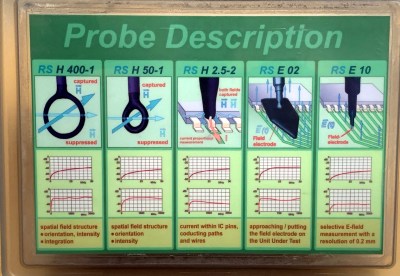These days we’re surrounded by high-speed electronics and it’s no small feat that they can all play nicely in near proximity to each other. We have RF emissions standards to thank, which ensure new products don’t spew forth errant signals that would interfere with the data signals traveling through the ether. It’s long been the stuff of uber-expensive emissions testing labs, and failure to pass can leave you scratching your head. But as Alex Whittimore shows in this workshop from the 2020 Hackaday Remoticon, you can do a lot of RF emissions debugging with simple and inexpensive tools.
You can get a surprisingly clear picture of what kind of RF might be coming off of a product by probing it on your own workbench. Considering the cost of the labs performing FCC and other certifications, this is a necessary skill for anyone who is designing a product headed to market — and still damn interesting for everyone else. Here you can see two examples of the probes used in the process. Although one is a pack of professional tools and other is a bit of enameled wire (magnet wire), both are essentially the same: a loop of wire on which a magnetic field will induce a very small current. Add a Low-Noise Amplifier (LNA) and you’ll be up and measuring in no-time.
I really enjoyed how Alex started his demo with “The Right WayTM” of doing things — using a proper spectrum analyzer to visualize data from the probes. But the real interesting part is “The Hacker WayTM” which leverages an RTL-SDR dongle and some open-source software to get the same job done. Primarily that means using SDRAngel and QSpectrumAnalyzer which are both included in the DragonOS_LTS which can be run inside of a virtual machine.
Once everything is hooked up and running, you wave the probes over your test board like a magic wand. Peaks will appear in the software visualization corresponding to emissions at that wavelength. Alex demonstrates starting with a large loop probe to get into the neighborhood, then swapping out probes for smaller and smaller loops to get all the way down to the pin on the chip where the signal is coming from.
The tools are cheap, the software is free, and we all should give this a try. Those lucky enough to have a HackRF in their toolkit will especially like the side-by-side comparison at the end of the workshop. It’s not surprising to see it kicking the butt of the RTL-SDR, but for basic debugging, simple tools are more than adequate to let you see what is normally unseeable.

















+1
“and again this at the limit of my RF experience”.
The Video is useful for some folk, and good that the basis of the presentation is inexpensive and accessible stuff, but you should probably go find an experienced EMC engineer to do this subject matter in the future. Compliance engineering is rather weird stuff – the confluence of applied physics and chemistry, math, quality control, legal statute, and social concerns.
A good place to start is the IEEE in general, and the EMC and PSES societies in particular.
But on the other hand, EMC engineers are mucho expensivo. So if you can reduce their workload by taking care of the low hanging fruit, it may save you a bit of money, even though you haven’t solved all potential problems.
Seems however, if you go beyond their SME technology threshold they have a hissy fit and never connect again.
I’m right you’re wrong and I’m through with you mentality. Guessing why the simple spiral conical and log periodic antennas aren’t DIY homebrew so much simply disclosed. I’ve gotten to the spiral conical antenna form with my one instructable and something higher up handles me not to detail much more regarding. Use your imagination station for the sequel with what I noted for design iterations.
That’s my experience and some are highly aggressive not wanting their “trade secrets” that are clearly publicly accessible broadcast if you read around the regs and papers.
I don’t think they’re as bad as the legal and medicine cartels that confuse people to death… though I’m certainly confident “they’re here.”
A wire at the right length soldered to a pad of a microcontroller, here is the radio of the poor:
https://hackaday.com/2018/10/29/short-length-of-wire-turns-stm32-microcontroller-into-good-enough-wireless-uart-blaster/